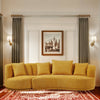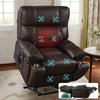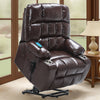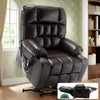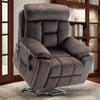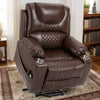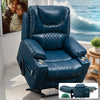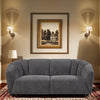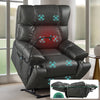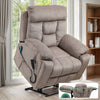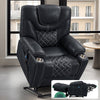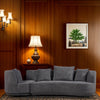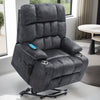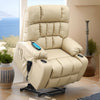Understanding the Appeal of Modular Sofas for Heavy Builds
The Evolution of Modular Furniture
Modular furniture has come a long way since its inception. It all started with simple, stackable units in the 1940s. Today, modular sofas are a game-changer in home design. They offer flexibility and style that traditional sofas can't match.

The concept of modular sofas evolved to meet changing lifestyles. People now want furniture that adapts to their needs. Modular sofas can be rearranged easily. This makes them perfect for various living spaces.
Over time, designers improved the comfort and durability of these sofas. They now cater to all body types, including those with heavier builds. The focus on inclusivity has made modular sofas a popular choice for many households.
Key Benefits of Adjustable Couches for Bigger and Heavier People
Adjustable couches offer several advantages for people with larger builds. Here are some key benefits:
- Enhanced Support: These sofas are designed to provide better weight distribution.
- Customizable Comfort: Users can adjust sections to their liking.
- Durability: High-quality materials ensure longevity, even with regular use.
- Spaciousness: Larger seating areas accommodate different body sizes comfortably.
- Versatility: Modular designs allow for various seating arrangements.
These features make adjustable couches an excellent choice for heavy people. They offer comfort without compromising on style or functionality. The ability to customize seating positions adds to their appeal.
Considerations When Selecting a Modular Sofa
When choosing a modular sofa, there are several factors to keep in mind. First, consider the weight capacity of the sofa. Ensure it can support heavier loads without compromising stability.
Look at the frame construction. A sturdy frame made of hardwood or metal is essential for durability. The cushion density is also crucial. Firmer cushions provide better support for heavier individuals.
Pay attention to the upholstery material. Opt for fabrics that are both durable and easy to clean. Leather can be a good choice for its strength and easy maintenance.
Lastly, check the modularity options. Make sure the sofa can be configured in ways that suit your space and needs. This flexibility is a key advantage of modular sofas.
How to Choose the Right Modular Sofa for Your Home
Assessing Space and Layout Compatibility
Choosing the right modular sofa starts with understanding your space. Measure your room carefully. Consider the traffic flow and existing furniture. This will help you determine the ideal size and configuration for your sofa.

Think about how you use the space. Do you need a large sectional for family gatherings? Or would a smaller, L-shaped arrangement work better? Modular sofas offer flexibility, but you need to plan ahead.
Consider the room's shape and any architectural features. Windows, doors, and fireplaces can impact sofa placement. Sketch out different layouts to visualize how the sofa will fit. Remember, modular sofas can be rearranged, so think about multiple configurations.
Quality and Durability: What to Look for
When investing in a modular sofa, quality and durability are key. Look for sofas with strong, well-constructed frames. Hardwood frames are typically more durable than softwood or particle board.
Check the joinery. Corners should be reinforced with metal brackets or dowels. This ensures stability, especially important for heavier users. The legs should be sturdy and securely attached to the frame.
Examine the suspension system. High-quality sofas often use eight-way hand-tied springs. These provide excellent support and durability. Sinuous springs can also be good if properly constructed.
Don't forget about the cushions. High-density foam offers the best support and longevity. Look for cushions with a mix of foam and down for comfort and durability. The upholstery should be tightly woven and resistant to wear and tear.
Comfort and Ergonomics: Adjustable Features and Support
Comfort is crucial, especially for those with heavier builds. Look for modular sofas with adjustable features. Reclining sections can provide customized comfort. Some sofas offer adjustable headrests or lumbar support.
Consider the seat depth and height. A deeper seat can be more comfortable for taller individuals. However, ensure your feet can touch the ground when seated. This promotes good posture and reduces strain.
Look for sofas with firm, supportive cushions. These will maintain their shape and support over time. Memory foam can be a good option as it molds to your body shape. However, it should be high-density to prevent sinking.
Ergonomic design is important for long-term comfort. Look for sofas with a slight recline in the backrest. This helps distribute weight evenly and reduces pressure on the lower back. Armrests should be at a comfortable height to support your arms and shoulders.
Enhancing Your Modular Sofa Experience in the United States
Incorporating Your Sofa into Various Living Spaces
Modular sofas are versatile and can fit into various living spaces. In a large living room, create a conversation pit with a U-shaped configuration. For smaller spaces, an L-shaped arrangement can maximize seating without overwhelming the room.

Consider using your modular sofa to divide open-plan spaces. A sofa with a chaise can separate living and dining areas. In a studio apartment, use the sofa as a room divider to create distinct zones.
Don't forget about outdoor spaces. Some modular sofas are suitable for covered patios or decks. This allows you to extend your living area and create an outdoor lounge. Just ensure the sofa is designed for outdoor use to withstand weather conditions.
Maintenance and Care Tips for Longevity
Proper care can extend the life of your modular sofa. Here are some maintenance tips:
- Vacuum regularly to remove dust and debris.
- Rotate cushions periodically to ensure even wear.
- Clean spills immediately to prevent staining.
- Use arm covers to protect high-wear areas.
- Follow manufacturer's cleaning instructions for upholstery.
For leather sofas, condition the material every 6-12 months. This prevents cracking and maintains softness. For fabric sofas, consider professional cleaning once a year to remove deep-set dirt.
Check and tighten any loose screws or fittings regularly. This maintains the sofa's stability and prevents wobbling. If you notice any tears or damage, repair them promptly to prevent further issues.
Exploring Customization Options for Your Adjustable Couch
Customization can make your modular sofa truly unique. Many manufacturers offer a range of upholstery options. Choose from different fabrics, colors, and patterns to match your decor. Leather is a popular choice for its durability and luxurious look.
Consider adding accessories to enhance functionality. Throw pillows can add comfort and style. Ottoman modules can provide extra seating or storage. Some sofas offer built-in USB ports or wireless charging pads for convenience.
Don't forget about leg options. Changing the legs can alter the sofa's look dramatically. Metal legs create a modern feel, while wooden legs offer a more traditional appearance. Some manufacturers even offer custom leg heights for a perfect fit.
Remember, the beauty of modular sofas lies in their flexibility. Feel free to experiment with different configurations. You can always rearrange the modules to create new looks and adapt to changing needs.







